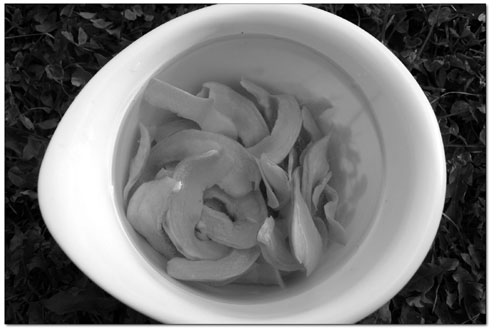| ||
Hung out to dry with the Bhutanese squash
by Chef Boy Ari "Actually, this one is nice when you dry it a little, but not completely, and cook it with cheese.” My Bhutanese friend Daw Gyem is talking about peppers, an item for which the Bhutanese have more words than the Eskimos have for snow. As usual, when talk turns to peppers, it will be mentioned that they are tasty when cooked with cheese. While ema-datse, the Bhutanese national character-defining dish of chiles and cheese, has been given much ink in this space, it’s hardly the only thing the Bhutanese know how to cook. Today, we’ll focus on kakur, or squash, which the Bhutanese like to dry and then cook with dried meat and chile peppers. What we call squash, the Bhutanse call “pumpkin.” And what they call squash sounds rather gross. “Our squash is green and hairy,” explains Daw Gyem’s husband, Tshewang. “We call it kewa beab, which means ‘potato frog.’” In the absence of refrigeration throughout most of Bhutan, the Bhutanese have become adept at drying their produce to preserve it. A whole range of dishes have evolved to use dried food, which behaves differently than fresh. “In summer, people long for dried vegetables, actually,” says Tshewang. “It’s turned into a pleasant way of preserving food that’s a delicacy unto itself.” A pressure cooker is required gear for cooking many of these dishes. To start off, Daw Gyem put some strips of beef and deer that had been dried overnight in a dehydrator. She added a little salt, closed the lid and began cooking. Soon we heard the sound of steam getting louder and louder, a hissing crescendo that seemed to scream, “it’s gonna blow!” Then it blew, with the sounds of a high-pressure hose bursting, and a huge blast of steam filled the kitchen. I was the only one who jumped at the sound, which I learned is part of the normal operating cycle of the Bhutanese-style pressure cooker, which is manufactured in neighboring India. The explosion, which they call a “whistling,” happens every few minutes. “Usually about nine or 10 whistlings and the meat is done,” explains Daw Gyem. “From the smell of the steam you can make out if it’s cooked,” she adds. “WhhheeeeeeePshhhhhh!!!” “Low-budget terrorists use pressure cookers to make bombs, actually,” Tshewang remarks. After about five whistlings, Daw Gyem put the pressure cooker in the sink and ran cold water over it to cool it down, then she opened it and added pieces of phag-sha sikam, which I call Bhutanese bacon: long strips of side pork that contain a strip of barely chewable skin along their edges. Phag-sha means “pig meat,” and sikam means “dried in cold air.” “Winter is a good time to air dry a lot of things, actually,” explains Daw Gyem. “Lots of sun, and in the cold air the meat doesn’t smell.” She closed the pressure cooker and put it on the stove for a few more whistlings. Then she took a handful of dried squash slices – prepared in a dehydrator from peeled blue hubbard squash –and put them in a bowl of water to rehydrate. Finally she peeled a large onion and about a half-head’s worth of garlic. While the meat heated, we discussed the finer points of Bhutanese pumpkins, which are often trained to climb onto rooftops. This makes sense, considering the extra space up there. And the weight of the pumpkins helps to hold down the roof, a task normally accomplished with heavy rocks. “Sometimes they grow between the rocks, actually, and take the shape of the space in-between,” says Daw Gyem. “WhhheeeeeeePshhhhhh!!!” Once the meat was cooked, she cooled the pressure cooker in the sink, opened it and removed the large chunks of phag-sha sikam, and cut them into “manageable chunks.” Then she sliced the onions, garlic and a tomato into the pot, holding said ingredients above the pot and cutting through them, toward her thumb, with the knife. “We don’t use cutting boards in Bhutan,” she says. Then she added the rehydrated pumpkin, which was the consistency of wet buckskin, salt and cooking oil, and then stirred in a bunch of sliced chile peppers, seeds and all. “You want to throw in the seeds because it’s hot and more tasty,” she explains. She added water to the pressure cooker so the contents would cook, but not burn, and put it back on the stove, covered but without pressure, for about 10 minutes. After the third helping, my belly protested but my mouth couldn’t stop eating, while my mind was amazed at this entirely new way of cooking local ingredients. The only nonlocal item, the “pig meat dried in cold air,” could be local. And believe me, if I had a pig – and if I lived in a place that was sunny in the winter – I’d try drying it that way, in cold air, next to my deer meat and squash. If you want to learn more about Bhutan, consider joining Chef Boy Ari on his trip there this January. E-mail flash@flashinthepan.net for details. •
|


